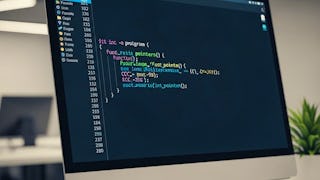This course provides an overview of System Programming for the Linux operating system, or software which is interfacing directly with the Linux Kernel and C library. The basic components of a Linux Embedded System, including kernel and root filesystem details are discussed. The Buildroot build system is introduced, which students use to build their own custom Embedded Linux system through programming assignments.

Enjoy unlimited growth with a year of Coursera Plus for $199 (regularly $399). Save now.

Linux System Programming and Introduction to Buildroot
This course is part of Advanced Embedded Linux Development Specialization

Instructor: Daniel Walkes
23,338 already enrolled
Included with
(139 reviews)
Recommended experience
What you'll learn
Fundamentals of Linux System Programming, including Processes and Threads.
How to build a custom Linux kernel and root filesystem for an Embedded device.
How to use Buildroot to build a custom Linux Kernel and root filesystem for an Embedded device.
Skills you'll gain
Details to know

Add to your LinkedIn profile
7 assignments
See how employees at top companies are mastering in-demand skills

Build your subject-matter expertise
- Learn new concepts from industry experts
- Gain a foundational understanding of a subject or tool
- Develop job-relevant skills with hands-on projects
- Earn a shareable career certificate

There are 4 modules in this course
In this module, you will learn about Linux shell scripting and System Programming concepts. You will also understand the basics of an Embedded Linux toolchain and setup a cross-compiler.
What's included
17 videos4 readings2 assignments2 peer reviews
In this module, you will learn the basics of File IO for Linux. You will understand the basics of Process Management, process forking, and Linux daemons. You will build your own Linux kernel and root filesystem, boot and run on QEMU.
What's included
11 videos2 readings2 assignments2 peer reviews
In this module, you will learn the basics of Threading and Multi Thread Synchronization in Linux system programming using POSIX. You will also learn about the Buildroot build system and build a QEMU Image using Buildroot.
What's included
10 videos2 readings2 assignments2 peer reviews
In this module, you will learn the fundamentals of signal handling and time management in Linux System Programming. You will learn the basic components of Embedded Linux debugging. You will implement a socket server application and deploy on a QEMU based Embedded System using Buildroot.
What's included
8 videos2 readings1 assignment2 peer reviews
Earn a career certificate
Add this credential to your LinkedIn profile, resume, or CV. Share it on social media and in your performance review.
Build toward a degree
This course is part of the following degree program(s) offered by University of Colorado Boulder. If you are admitted and enroll, your completed coursework may count toward your degree learning and your progress can transfer with you.¹
Instructor

Offered by
Explore more from Software Development
 Status: Free Trial
Status: Free TrialUniversity of Colorado Boulder
 Status: Free Trial
Status: Free TrialUniversity of Colorado Boulder
 Status: Preview
Status: Preview Status: Free Trial
Status: Free TrialUniversity of Colorado Boulder
Why people choose Coursera for their career




Learner reviews
139 reviews
- 5 stars
61.87%
- 4 stars
21.58%
- 3 stars
6.47%
- 2 stars
2.87%
- 1 star
7.19%
Showing 3 of 139
Reviewed on Jan 10, 2023
linux system programmingand intro to build root program is very good it helped me lot to learn concept
Reviewed on Nov 23, 2024
A good hands-on course that provides all the Knowledge, and a Little self-study with the resources mentioned in the course can make you a MASTER.
Reviewed on Mar 14, 2024
I really loved this course, can't wait to resume on 2nd and 3rd part of it.

Open new doors with Coursera Plus
Unlimited access to 10,000+ world-class courses, hands-on projects, and job-ready certificate programs - all included in your subscription
Advance your career with an online degree
Earn a degree from world-class universities - 100% online
Join over 3,400 global companies that choose Coursera for Business
Upskill your employees to excel in the digital economy
Frequently asked questions
Course logo designed using https://commons.wikimedia.org/wiki/File:Tux.svg lewing@isc.tamu.edu Larry Ewing and The GIMP and used with permission.
To access the course materials, assignments and to earn a Certificate, you will need to purchase the Certificate experience when you enroll in a course. You can try a Free Trial instead, or apply for Financial Aid. The course may offer 'Full Course, No Certificate' instead. This option lets you see all course materials, submit required assessments, and get a final grade. This also means that you will not be able to purchase a Certificate experience.
When you enroll in the course, you get access to all of the courses in the Specialization, and you earn a certificate when you complete the work. Your electronic Certificate will be added to your Accomplishments page - from there, you can print your Certificate or add it to your LinkedIn profile.
More questions
Financial aid available,

